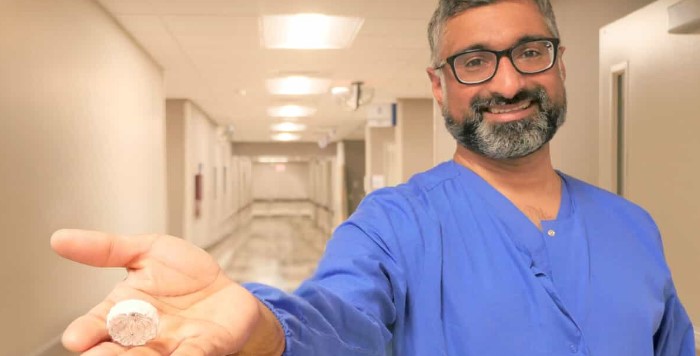Dr. Alexander Performs 100th Watchman Procedure for AFib Treatment
- Category: Heart & Vascular
- Posted On:

Winchester Medical Center Heart and Vascular Team Marks AFib Treatment Milestone
Valley Health Winchester Medical Center’s Watchman team paused briefly at the end of March (2022) to recognize cardiologist and electrophysiologist Daniel Alexander, DO, for completing his 100th procedure to implant a device in the heart to help prevent stroke in certain patients with Atrial Fibrillation (AFib).
Dr. Alexander, with Winchester Cardiology and Vascular Medicine | Valley Health colleagues Saif Al-Najafi, MD, and Jeffrey Skiles, MD, leads a larger team of anesthesia, imaging, and support staff that, since late 2018, has helped 157 area residents with AFib improve their quality of life and stroke risk with the tiny Watchman FLX™ device.
“After completing 100 Watchman procedures, I am confident in the effectiveness of the device and the peace of mind it offers to patients with non-valvular Atrial Fibrillation who are unable to take an anticoagulant the rest of their lives to prevent stroke,” said Dr. Alexander. He is board-certified in cardiology and electrophysiology, and serves as Chair of the WMC Electrophysiology Clinical Council.
The AFib-Stroke Connection
AFib – an irregular heartbeat that feels like a quivering heart – is a common heart rhythm disorder that affects an estimated six million Americans. The heart muscle in AFib squeezes irregularly, increasing by 500% the odds for a blood clot to form and travel to the brain, causing an ischemic stroke, Dr. Alexander explained. “Ninety percent of clots that lead to a stroke in an individual with AFib form in a small pocket near the top of the heart called the left atrial appendage (LAA). Preventing clots from forming and leaving the heart is a top priority,” he said.
AFib treatment may include dietary and other lifestyle recommendations, medications to thin the blood and manage related issues, or cardiac ablation to control heart rhythms. Many with AFib cannot take a blood thinner due to kidney disease, interactions with other medications, or a high risk of bleeding. For these patients, the Watchman FLX device can be a lifesaver.
The Watchman Procedure
The Watchman device is placed in the heart using a minimally invasive endovascular procedure, under general anesthesia. “The Watchman looks like a little umbrella without a handle,” said Dr. Al-Najafi, who specializes in the advanced cardiac imaging used before and during the procedure. “All the tools -- and the device itself -- are inserted through a small incision in the femoral vein of the leg and threaded up to the heart.”
The Watchman procedure takes about an hour and patients stay overnight in the hospital. Over the following weeks and months, heart tissue grows around the device, securing it in place and blocking the opening of the LAA so clots cannot escape into circulation. It is a permanent solution and will not need replacement. More than 150,000 patients worldwide have received the Watchman technology.


